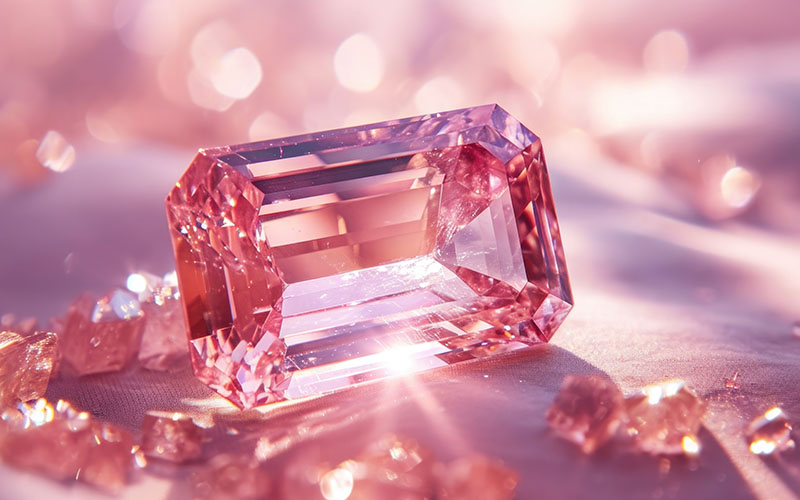When a gemologist talks about dispersion the phenomenon being described is scientifically repeatable from diamond to diamond. The material has a fixed refractive index which reliably disperses light. And, while a diamond’s cut-geometry influences dispersive-output, the phenomenon of “dispersion” itself is a physical constant.
When a jeweler talks about fire, however, a variable aesthetic is being described: “This diamond has more fire than that one.” And indeed, fire’s appearance is variable. Not just diamond to diamond – the same diamond presents with different fire in different environments. And, depending on acuity, eyesight and age, it even varies from observer to observer (did you know that?).
Fortunately, the fact that these terms have been co-mingled and transposed over time creates an opportunity to revisit them and sharpen our skills as communicators.
It may also be cool to engage your customers with these hows and whys ~ involving their eyes.
Dispersion vs Fire
Dispersion occurs physically, within the diamond.
Fire occurs physiologically, at the human eye.
Permit me to elaborate.
1. What is dispersion?
Light in the visible spectrum is composed of a rainbow of colors. All-seen together, we perceive the light as white.

Dispersion occurs between non-parallel transparent surfaces, like a glass prism or a gemstone’s facets. Upon entry the different colors in the visible spectrum begin traveling at different speeds – separating, or ‘dispersing’ from each other.
Short wavelengths (near UV) travel more slowly than long wavelengths (near IR).

Dispersion in diamonds
As a transparent material diamond’s high refractive index promotes strong dispersion. With that said there are other factors which influence a diamond’s dispersive-output.
The influence of cut-proportions
When light entering a diamond’s crown approaches a pavilion facet at an angle that’s lower than diamond’s critical angle it will exit the pavilion, failing to return to the viewer’s eye. But if that angle is higher than diamond’s critical angle, it will be reflected back within the stone.
- Shallow or Deep geometries cause light behavior deficits which can suppress brightness and dispersion.
- Proportionate diamonds return light to the viewer’s eye, promoting brightness and dispersion.

The influence of lighting
- Strong, direct light sources of small angular size promote dispersion. This is why jewelry stores frequently incorporate such lighting overhead.
- Diffused light sources promote brightness but suppress dispersion.
In the most common real-world application, gemstone dispersion is suppressed on cloudy days (under diffused light) but highly promoted on clear, sunny days (under strong, direct light).

The images above show the dispersive-output of a 0.76 carat round brilliant in direct sunlight. The images on the right show dispersive-fans landing 20-40cm from the crown, clearly separated into their component colors.
That covers dispersion.
2. What is fire?
Fire is human perception of dispersion.
Human physiology
When a dispersive-fan of rainbow colors passes across your eye there are two factors which dictate whether or not you perceive that dispersion as “Fire.”
- The size of the dispersive-fan
- The constriction or dilation of your pupil at the time
If the fan arrives to your eye and is large enough that only red enters your pupil your brain sees a red flash. If green enters you see a green flash. If blue enters you see a blue flash (etc). But if the dispersive-fan is physically smaller than the diameter of your eye’s pupil all colors enter simultaneously and recombine, so your brain sees a white flash or, if too small, nothing at all.

The person below is seeing a flash of blue fire. That’s because only blue is entering the pupil. The red, yellow and green portions of the dispersive-fan appear on the iris. They are not entering the pupil, so are unseen.
If that dispersive-fan moves across the eye from left to right the blue-flash could become seen as blue fire, green fire, yellow fire and red fire, in sequence.

Summary
If a dispersive-fan passes over your eye and is wider than your pupil’s diameter you will see a colored flash. If a dispersive fan passes over your eye but is smaller than your pupil’s diameter the light recombines and you see a white flash. If the fan is too small or weak you see nothing. In optimal cases a single, wide dispersive-fan passing across your pupil may cause you to see a full suite of shifting chromatic colors.
Under conducive lighting, well-cut diamonds are capable of producing hundreds of different sized dispersive-fans simultaneously. Those which are wider than your pupil’s diameter when arriving to your eye are seen as fire.
Dispersion occurs in all eight panels. Fire is only seen in four of them.

Dispersion vs Fire
Dispersion occurs physically, within the diamond.
Fire occurs physiologically, at the human eye.
So dispersion is not fire. Dispersion creates the potential for a human brain to perceive fire. But whether you see fire in a diamond and how much you see, depends on how it was cut, the panorama of illumination and your own physiology.




